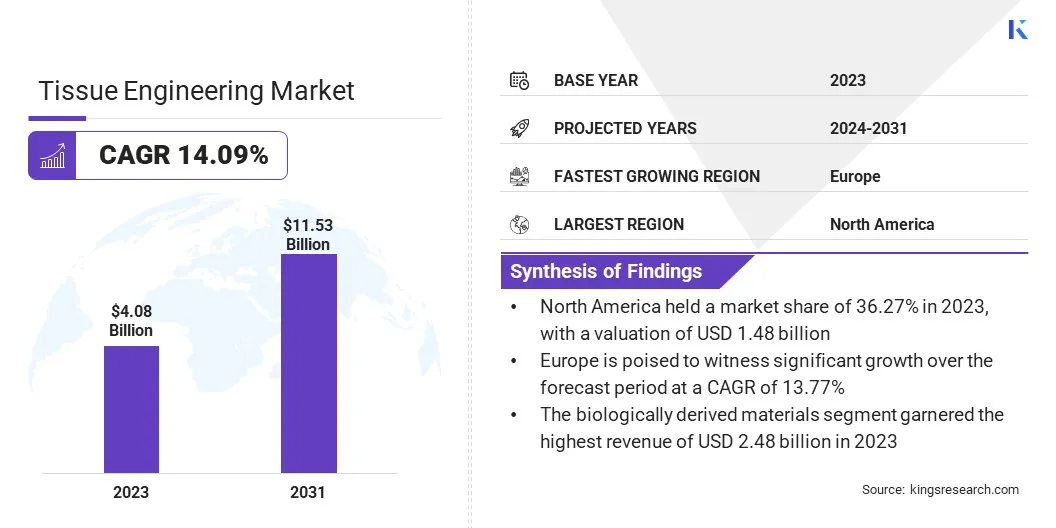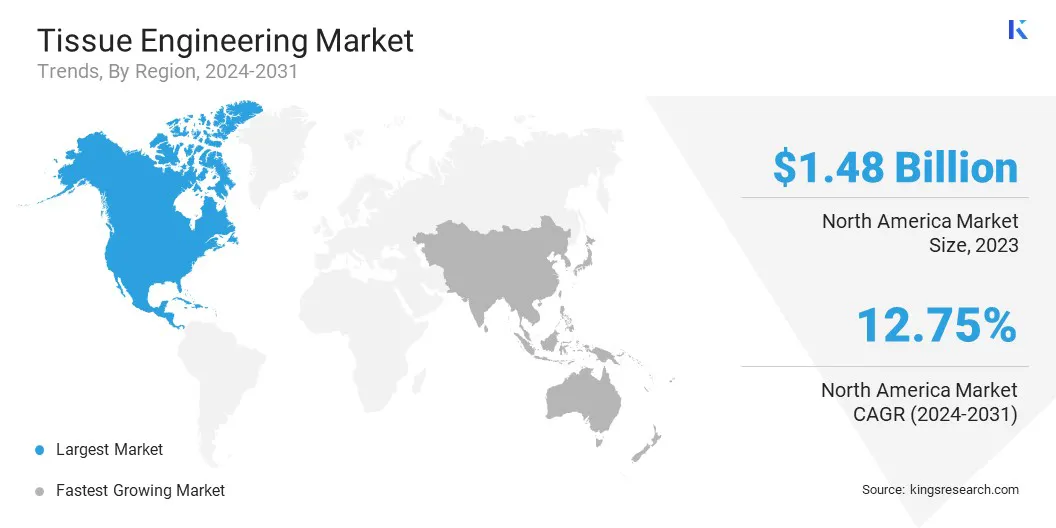Tissue Engineering Market Size
The global Tissue Engineering Market size was valued at USD 4.08 billion in 2023 and is projected to reach USD 11.53 billion by 2031, growing at a CAGR of 14.09% from 2024 to 2031. In the scope of work, the report includes solutions offered by companies such as Organogenesis Holdings Inc., Acelity L.P. Inc., Integra LifeSciences Holdings Corporation, Stryker Corporation, Vericel Corporation, Medtronic plc, Zimmer Biomet Holdings, Inc., Smith & Nephew plc, Tissue Regenix Group plc, CryoLife, Inc. and Others.
The rising incidence of chronic diseases worldwide is a significant factor fueling the demand for advanced therapies such as tissue engineering solutions. Chronic diseases such as cardiovascular diseases, diabetes, and orthopedic disorders are becoming more prevalent due to several factors such as aging populations, sedentary lifestyles, and dietary changes. These conditions often lead to tissue damage or organ failure, necessitating innovative treatments beyond traditional pharmaceutical interventions.
Tissue engineering offers promising solutions by utilizing principles from biology, engineering, and material science to regenerate damaged tissues or organs. The burgeoning demand for tissue engineering technologies is further fueled by the limitations of existing treatments, increasing healthcare costs, and the preference for personalized and long-lasting therapeutic outcomes.
As research and development efforts continue to advance, tissue engineering is anticipated to play a crucial role in addressing the growing prevalence of chronic diseases globally. Tissue engineering is a multidisciplinary field combining principles from engineering, biology, and material science to create biological substitutes that restore, maintain, or improve tissue function.
It finds applications across orthopedics & musculoskeletal disorders, dental disorders, cardiovascular diseases, dermatology & wound care, and other areas. Technological advancements, such as 3D bioprinting, gene editing, and biomaterial innovations, are revolutionizing tissue engineering capabilities, allowing for precise control over tissue structure, function, and integration.
However, these advancements face regulatory challenges related to safety, efficacy, and ethical considerations, especially concerning stem cell use and genetic engineering. Regulatory bodies play a crucial role in ensuring patient safety and product quality, thereby driving the need for robust preclinical testing, clinical trials, and compliance with evolving regulatory standards.

Analyst’s Review
Businesses in the tissue engineering market are aiming to invest in research and development to drive innovation, fostering collaborations with academia, industry, and regulatory bodies to accelerate product development. These strategies are playing a crucial role in enhancing the adoption of advanced manufacturing technologies such as 3D printing and bioprinting for scalable production of tissue-engineered products and navigating regulatory pathways effectively to ensure compliance and commercialization success.
These strategies are valuable as they enable companies to differentiate their offerings, address unmet clinical needs, and seize market opportunities. These strategies are expected to be crucial as the market expands, competition intensifies, and the demand for personalized and effective tissue engineering solutions grows.
Tissue Engineering Market Growth Factors
Technological advancements such as 3D printing, bioprinting, advanced biomaterials, and tissue culture techniques are significantly enhancing tissue engineering capabilities. The utilization of 3D printing and bioprinting technologies allows precise layer-by-layer deposition of cells and biomaterials, enabling the fabrication of complex tissues and organs with customized architectures.
Advanced biomaterials provide scaffolds that mimic native tissue properties, thereby promoting cell adhesion, proliferation, and differentiation. Tissue culture techniques, including organ-on-a-chip models and bioreactors, simulate physiological conditions for cell growth and tissue development, which enhances tissue functionality and facilitates post-transplantation integration.
These advancements improve the efficiency and accuracy of tissue engineering processes and enable the production of patient-specific tissues and organs for personalized therapeutic applications, thus driving innovation and growth in the tissue engineering market.
However, high development costs in tissue engineering, including research, preclinical studies, clinical trials, regulatory compliance, and manufacturing, are posing significant challenges for small companies entering the market. The complexity of tissue engineering technologies and the need for specialized expertise further contribute to cost escalation.
These high costs often create barriers to market entry, limiting the ability of small players to compete with larger companies. To mitigate this challenge, companies are aiming to collaborate with academic institutions, research organizations, and industry networks to facilitate resource-sharing and knowledge exchange, enabling them to navigate the competitive landscape and contribute to market development.
Tissue Engineering Market Trends
The tissue engineering market is witnessing a significant shift toward personalized and precision medicine approaches, mainly driven by advancements in biomaterials, cell therapies, and genetic engineering. Personalized medicine tailors treatments to individual patient characteristics, optimizing therapeutic outcomes and minimizing adverse effects.
In tissue engineering, this translates to creating patient-specific tissues and organs using bioengineered constructs and patient-derived cells, which enhances compatibility and reduces rejection risks. Moreover, the integration of advanced manufacturing technologies, such as 3D printing and bioprinting, enables the production of complex, multi-material structures with precise spatial control, thereby supporting tissue organization and functionality.
These trends are shaping market dynamics by offering innovative solutions for personalized regenerative therapies, disease modeling, drug testing, and organ transplantation. The continued integration of digital technologies and regenerative medicine approaches is anticipated to drive advancements in personalized tissue engineering and transformative healthcare solutions.
Segmentation Analysis
The global market is segmented based on application, material, and geography.
By Application
Based on application, the market is segmented into orthopedics & musculoskeletal disorders, dental disorders, cardiovascular diseases, and dermatology & wound care. The orthopedics & musculoskeletal disorders segment dominated the tissue engineering market with a substantial share of 41.08% in 2023. The segment addresses a wide range of clinical needs, including bone fractures, joint injuries, cartilage defects, and spinal disorders, which are prevalent among diverse patient populations globally.
Moreover, advancements in biomaterials, tissue engineering techniques, and orthopedic implant technologies have expanded treatment options, driving their adoption among healthcare providers and patients. The aging population and increasing occurrences of sports-related injuries have further contributed to the growing demand for orthopedic tissue engineering solutions., thereby supporting segment growth.
By Material
Based on material, the tissue engineering market is bifurcated into synthetic materials and biologically derived materials. The biologically derived materials segment garnered the highest revenue of USD 2.48 billion in 2023.
Biologically derived materials, such as collagen, fibrin, hyaluronic acid, and extracellular matrix components, offer inherent biocompatibility, promote cell adhesion, and mimic natural tissue environments, making them ideal for tissue engineering applications. These materials are extensively used in regenerative medicine approaches for wound healing, tissue repair, and organ regeneration due to their ability to support cell growth and tissue integration.
Moreover, the growth of the segment is driven by ongoing research and development efforts focused on enhancing biomaterial properties, optimizing manufacturing processes, and exploring novel sources of biologically derived materials. Additionally, regulatory approvals and increased adoption of biologically derived materials in clinical settings are set to augment segment revenue.
Tissue Engineering Market Regional Analysis
Based on region, the global market is classified into North America, Europe, Asia-Pacific, MEA, and Latin America.

The North America Tissue Engineering Market share stood around 36.27% in 2023 in the global market, with a valuation of USD 1.48 billion. The region boasts a robust healthcare infrastructure, coupled with significant investments in research and development, which is fostering innovation and commercialization in tissue engineering technologies.
- Leading academic institutions, research centers, and biotechnology companies in the U.S. and Canada are fostering advancements in regenerative medicine and tissue engineering, which, in turn, are attracting investments and talent from across the globe.
Additionally, favorable regulatory frameworks and supportive reimbursement policies are incentivizing market players to develop and launch innovative tissue engineering products and therapies. Moreover, a growing prevalence of chronic diseases, an aging population, and high healthcare expenditures are driving the demand for advanced tissue engineering solutions for orthopedics, cardiovascular diseases, wound care, and other therapeutic areas.
These factors have positioned North America as a key hub for tissue engineering advancements, presenting potential opportunities for sustained growth and technological breakthroughs.
Europe is poised to witness significant growth over the forecast period at a CAGR of 13.77%. Increasing investments in regenerative medicine research, collaborations between academia and industry, and government initiatives supporting healthcare innovation are driving technological advancements and product developments in tissue engineering. Countries such as Germany, the U.K., and Switzerland have strong biotechnology and healthcare sectors, thereby fostering a conducive environment for tissue engineering market growth.
Additionally, a growing aging population and rising prevalence of chronic diseases such as osteoarthritis, cardiovascular disorders, and skin conditions create demand for tissue engineering solutions for personalized and effective treatments.
Moreover, favorable regulatory landscapes with clear guidelines for product approvals, coupled with reimbursement support for innovative therapies, prompt industry players to invest in European markets for commercialization and expansion opportunities. The integration of advanced manufacturing technologies, surging emphasis on personalized medicine approaches, and collaborations across European research networks are further propelling the growth of the regional market.
Competitive Landscape
The global tissue engineering market report will provide valuable insight with an emphasis on the fragmented nature of the industry. Prominent players are focusing on several key business strategies such as partnerships, mergers and acquisitions, product innovations, and joint ventures to expand their product portfolio and increase their market shares across different regions.
Strategic initiatives, including investments in R&D activities, the establishment of new manufacturing facilities, and supply chain optimization, could create new opportunities for market growth.
List of Key Companies in Tissue Engineering Market
- Organogenesis Holdings Inc.
- Acelity L.P. Inc.
- Integra LifeSciences Holdings Corporation
- Stryker Corporation
- Vericel Corporation
- Medtronic plc
- Zimmer Biomet Holdings, Inc.
- Smith & Nephew plc
- Tissue Regenix Group plc
- CryoLife, Inc.
Key Industry Developments
- March 2024 (Partnership): BSF Enterprise partnered with Ivy Farm to aid advancement in tissue engineering. The collaboration involved sharing resources and expertise to develop innovative solutions in the field. This collaboration highlighted the growing importance of partnerships and collaborations in driving advancements in tissue engineering technologies, which hold substantial promise in healthcare and regenerative medicine applications.
- July 2023 (Launch): The Department of Science and Technology (DOST), in the Philippines, together with Pharma Galenx, launched a state-of-the-art bioprinting laboratory, thereby advancing tissue engineering in the country. This collaboration was aimed to enhance research capabilities in the development of biofabricated tissues and organs. This initiative marked a significant step towards implementing innovative solutions in the tissue engineering market.
The Global Tissue Engineering Market is Segmented as:
By Application
- Orthopedics & Musculoskeletal Disorders
- Dental Disorders
- Cardiovascular Diseases
- Dermatology & Wound Care
By Material
- Synthetic Materials
- Biologically Derived Materials
By Region
- North America
- Europe
- France
- U.K.
- Spain
- Germany
- Italy
- Russia
- Rest of Europe
- Asia-Pacific
- China
- Japan
- India
- South Korea
- Rest of Asia-Pacific
- Middle East & Africa
- GCC
- North Africa
- South Africa
- Rest of Middle East & Africa
- Latin America
- Brazil
- Argentina
- Rest of Latin America


